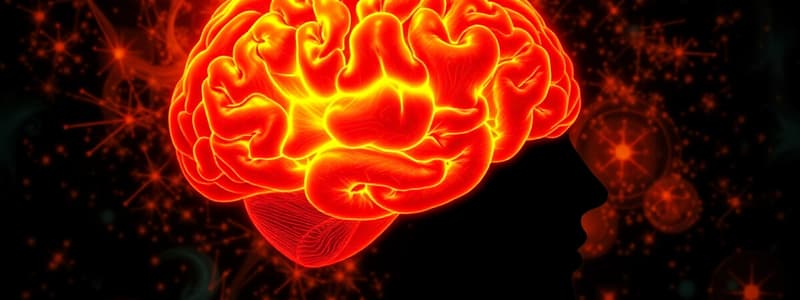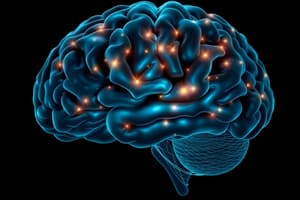Podcast
Questions and Answers
Which of the following scenarios best illustrates the interplay between bottom-up and top-down processing in emotional responses?
Which of the following scenarios best illustrates the interplay between bottom-up and top-down processing in emotional responses?
- Feeling a sudden jolt of fear when hearing a loud bang, followed by immediately running away.
- Experiencing a racing heart upon seeing a snake and then consciously deciding to remain calm by reminding oneself it's in a zoo enclosure. (correct)
- Ignoring the feeling of hunger until class ends, then immediately grabbing a snack afterwards
- Focusing intently on a puzzle, overlooking all other stimuli in the room momentarily.
A person with damage to their amygdala would MOST likely exhibit difficulty in which of the following?
A person with damage to their amygdala would MOST likely exhibit difficulty in which of the following?
- Coordinating voluntary movements in response to emotional stimuli.
- Identifying potentially threatening stimuli in their environment. (correct)
- Consciously appraising and worrying about potential threats.
- Experiencing subjective feelings associated with physical sensations.
Which brain area is MOST responsible for the conscious appraisal of threat and the experience of worry?
Which brain area is MOST responsible for the conscious appraisal of threat and the experience of worry?
- The basal ganglia
- The nucleus accumbens
- The cingulate cortex (correct)
- The insula
Damage to the frontal lobes would MOST likely result in which of the following behavioral changes?
Damage to the frontal lobes would MOST likely result in which of the following behavioral changes?
Which of the following scenarios BEST describes the primary function of the insula?
Which of the following scenarios BEST describes the primary function of the insula?
Flashcards
Emotional Responses
Emotional Responses
Combines sensory input with cognitive appraisal to shape emotional responses.
Sympathetic Division
Sympathetic Division
Part of the autonomic nervous system responsible for fight-or-flight responses.
Amygdala
Amygdala
Identifies emotional stimuli and orchestrates responses via connections with other brain areas.
Insula
Insula
Signup and view all the flashcards
Basal Ganglia
Basal Ganglia
Signup and view all the flashcards
Study Notes
- Emotional responses integrate bottom-up processing, where lower nervous system parts alert the cerebral cortex, and top-down processing, where cortical executive functions adjust lower structure activity.
- The autonomic system, governed by the hypothalamus, manages general arousal and negative emotions.
- The sympathetic division initiates the fight-or-flight response.
- Hypothalamus activity is directly related to fear of predation.
- The amygdala identifies emotional triggers, activates responses through circuits connected to the hypothalamus, frontal lobes, cingulate cortex, and insula.
- Amygdala damage impairs fear response and emotion identification, leading to less intense emotions.
- The amygdala actively involved in interpreting social interactions
- The insula, located where the frontal and temporal lobes meet, is key for subjective feelings.
- The back of the insula is linked to physical sensations like heart rate and pain, while the front is associated with overall feelings.
- The cingulate cortex, connected with frontal brain areas and subcortical structures, is involved in consciously assessing threats, catastrophizing, and worry.
- Basal ganglia coordinates voluntary movements and responses of disgust to emotional stimuli.
- The nucleus accumbens is central to pleasure and reward, playing a role in addiction.
- Frontal lobe damage diminishes emotional intensity, leading to impulsive and risky behaviors.
- Different emotions trigger unique activity patterns, and a single brain region can be involved in multiple emotions.
Studying That Suits You
Use AI to generate personalized quizzes and flashcards to suit your learning preferences.




